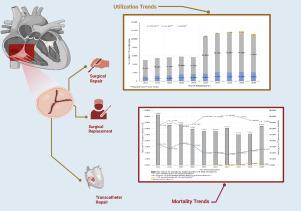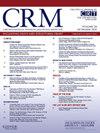三尖瓣反流手术和经导管介入治疗的趋势:2011年至2020年全国住院病人样本分析。
IF 1.9
Q3 CARDIAC & CARDIOVASCULAR SYSTEMS
引用次数: 0
摘要
背景:三尖瓣反流(TR)对健康造成极大的负担,严重的疾病会导致不良的长期预后,包括顽固性右心衰竭。尽管指南提倡进行干预,但由于死亡率较高,手术方案历来受到限制。经导管瓣膜介入治疗(TTVI)的进步重新激发了人们对微创治疗的兴趣:本研究利用 2011 年至 2020 年的全国住院患者样本(NIS)数据,分析了全美手术和经导管三尖瓣介入治疗的趋势、影响手术选择的因素和结果。分析包括 98,202 例介入治疗,研究了接受经导管三尖瓣成形术、外科三尖瓣修复术(STVr)和外科三尖瓣置换术(STVR)的患者的人口统计学和临床差异:结果:分析了 2011 年至 2020 年间的 98,202 例电视介入治疗。随着时间的推移,电视介入手术总数有所增加,TTVI 在 2020 年达到峰值(4.8%)。STVr从78.20%(2011年)下降到76.80%(2020年),而STVR从21.80%下降到18.40%。影响手术选择的因素包括年龄、种族、医院规模、教学状况和合并症。在电视手术相关死亡病例中,STVR所占比例最高,其次是STVr和TTVI。随着时间的推移,STVR相关死亡人数有所下降,而STVr相关死亡人数则有所上升:这项研究为死亡率趋势提供了一个有用的直观表述,可以让医疗专业人员了解电视手术结果的变化情况。有必要进行进一步分析,以了解这些趋势的根本原因,如随着时间的推移,患者人口统计学、手术量、技术和临床实践的变化。本文章由计算机程序翻译,如有差异,请以英文原文为准。

Trends in surgical and transcatheter interventions for tricuspid regurgitation: A national inpatient sample analysis from 2011 to 2020
Background
Tricuspid regurgitation (TR) poses a significant health burden, with severe disease linked to poor long-term outcomes, including intractable right heart failure. Despite guidelines advocating intervention, surgical options have historically been limited due to high mortality rates. Advancements in transcatheter valve interventions (TTVI) have renewed interest in less invasive treatments.
Methods
Utilizing data from the National Inpatient Sample (NIS) spanning 2011 to 2020, this study analyzed trends, factors influencing procedure selection, and outcomes of surgical and transcatheter tricuspid valve interventions across the United States. The analysis included 98,202 interventions, examining demographic and clinical disparities among patients undergoing TTVI, surgical tricuspid valve repair (STVr), and surgical tricuspid valve replacement (STVR).
Results
Between 2011 and 2020, 98,202 TV interventions were analyzed. Over time, total TV interventions increased, with TTVI peaking in 2020 (4.8 %). STVr declined from 78.20 % (2011) to 76.80 % (2020), while STVR decreased from 21.80 % to 18.40 %. Factors influencing procedure selection included age, race, hospital size, teaching status, and comorbidities. STVR accounted for the highest proportion of TV procedure-related deaths, followed by STVr and TTVI. STVR-related deaths declined over time, while STVr-related deaths increased.
Conclusion
This study provides a helpful visual representation of mortality trends and can inform healthcare professionals about the changing landscape of TV procedure outcomes. Further analysis would be necessary to understand the underlying causes of these trends, such as changes in patient demographics, procedural volume, technology, and clinical practices over time.
求助全文
通过发布文献求助,成功后即可免费获取论文全文。
去求助
来源期刊

Cardiovascular Revascularization Medicine
CARDIAC & CARDIOVASCULAR SYSTEMS-
CiteScore
3.30
自引率
5.90%
发文量
687
审稿时长
36 days
期刊介绍:
Cardiovascular Revascularization Medicine (CRM) is an international and multidisciplinary journal that publishes original laboratory and clinical investigations related to revascularization therapies in cardiovascular medicine. Cardiovascular Revascularization Medicine publishes articles related to preclinical work and molecular interventions, including angiogenesis, cell therapy, pharmacological interventions, restenosis management, and prevention, including experiments conducted in human subjects, in laboratory animals, and in vitro. Specific areas of interest include percutaneous angioplasty in coronary and peripheral arteries, intervention in structural heart disease, cardiovascular surgery, etc.
 求助内容:
求助内容: 应助结果提醒方式:
应助结果提醒方式:


